Hastings Pier was proclaimed to be the ‘peerless pier’ when it opened in 1872.
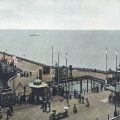 |
 |
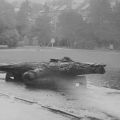 |
 |
 |
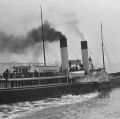 |
 |
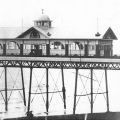 |
 |
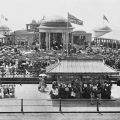 |
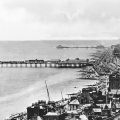 |
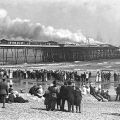 |
 |
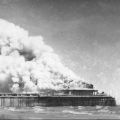 |
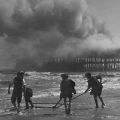 |
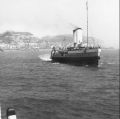 |
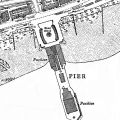 |
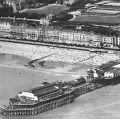 |
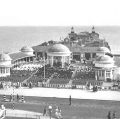 |
 |
 |
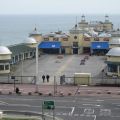 |
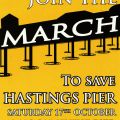 |
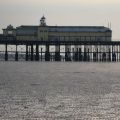 |
 |
 |
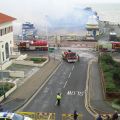 |
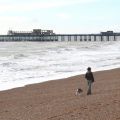 |
 |
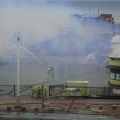 |
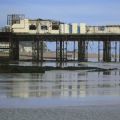 |
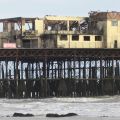 |
 |
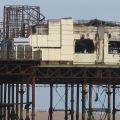 |
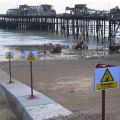 |
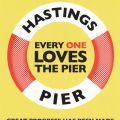 |
The 1872 pier immediately became the resort’s main tourist attraction, and remained so until the late 1970s. The high-point of its popularity came in the 1930s, the boom-time for Hastings as a seaside resort, when the pier’s theatre, ballroom, restaurant, shops, amusements, bandstand, speedboats, steamers, angling facilities and illuminations brought hundreds of thousands of people through its tollgate every year.
But serious problems began in the early 1980s. Nationally, seaside piers started falling out of fashion, and many of them experienced financial problems similar to those seen at Hastings from then onwards. The decline of Hastings Pier from the early '80s, however, was worsened by the failure of its succession of owners to invest in maintaining its structure. Then, on 5 October 2010, fire swept the length of the listed building, destroying 95% of everything above deck level. The pier’s future now hangs in the balance; the structure could be made useable again, and new attractions built on it - but only if grants of many millions of pounds can be obtained.
The 1860s
Anyone standing on Hastings Pier just before the 2010 fire would have seen nothing of the original Victorian ‘peerless pier’. The only things that had survived since 1872 were the out-of sight iron posts and gantry underneath the deck.
The first seeds of the pier were sown in late 1860, when a group of local speculators, including several councillors, set up the Hastings Floating Harbour Association. This initially aimed to build a small harbour, consisting of a single floating arm chained to the seabed, off the Old Town. But in 1861 the local entrepreneurs turned this proposal into a much bigger plan: a two-arm 57 acre harbour in front of the Old Town, which included using the harbour arms as public ‘promenade piers’, then becoming fashionable. At the same time, another company, the Pier and Harbour Company, came onto the scene from out of town, with similar plans for a harbour and pier.
This sudden surge of interest in building piers followed the passing of the 1861 General Pier and Harbour Act, which sought to "encourage and facilitate the formation, management and maintenance of piers and harbours" all round the coast of Great Britain. Among other things, it gave the promoters the power to obtain loans from the National Debt Commissioners.
Until the construction of the railways throughout Britain in the 1840s, ‘50s and ‘60s, piers were primarily landing stages for boats bringing health-seeking visitors to the seaside towns. But the railways conveyed many middle class pleasure seekers to the seaside who liked ‘promenading’ not only along seafronts, but also on piers, above the waves. From the late 1850s the new pleasure piers began appearing around the coast – simple structures carrying no buildings but making an excellent promenade.
For most of the 1860s there was a bitter fight between the Hastings establishment and the non-local company over which would win the prize of building a pier and/or a harbour. The winner on points was to be the out-of-town Pier and Harbour Company, led by Britain’s most prolific and famous pier builder, Eugenius Birch. Born 1818, Birch was a doyen of pier engineers, and had been involved in railway and bridge works in his early life. His first pier was Margate, built 1853-6. By the time of his death in 1884 he had been the engineer of another 13 piers, including Brighton West, Eastbourne and Hastings.
Despite lack of support from Hastings Council, the Pier and Harbour Company obtained the legal powers necessary to build any such structure using the 1861 Act. But the project never came to fruition because of the default of the contractor, plus steadily growing local opposition. Many local people believed a harbour would reduce the town’s growing character as a fashionable resort, plus councillors and traders wanted the profits to be made by their venture, not by a company run by people unconnected with the town.
Another problem for the Pier and Harbour Company was the requirement under the 1861 Act that the harbour should be built before the pier, and this all required massive funding.
In 1865 Birch and his company produced a new proposal: to separate their two projects, with the pier being at White Rock and the harbour remaining at the Old Town. They also drew up plans for a pier at Warrior Square, to be called the Alexandra Pier, but this was soon dropped.
The secretary of the Pier and Harbour Company was Mr WH Simpson, a solicitor who was involved in several other piers, including Brighton West, of which he said he was the sole promoter. He had lived in the Hastings area since 1839 and said he wanted to benefit the town, but he was seen by the local establishment as an outsider, acting for London business interests. By 1865 he was up against fierce opposition, and he said “there was a great hostility to the plan amongst some members of the Council, because these gentlemen [councillors] wished to carry out a plan of their own”.
The most vociferous of these councillors was leading local builder John Howell, an influential Liberal. In 1866 Howell was given a £25,000 contract by his fellow councillors to build major drainage facilities across the town, and he had his eyes on a similar sum for a pier. But he had no guarantee of laying his hands on that contract if the pier company was not controlled by his fellow local freemasons – and the Pier and Harbour Company was not. In addition, the 1861 Act gave Simpson’s company certain exclusive legal rights for building a pier in Hastings, putting serious constraints on any other scheme, including any backed by Hastings Council.
But the Hastings terms of the 1861 Act were due to expire in July 1867, so in December 1866, with the Pier and Harbour Company dormant, Simpson held a public meeting to promote his own new parliamentary bill. He was now proposing just a ‘pleasure pier’, without a harbour. He offered the setting up and running of the scheme to the people of the town, on condition he was employed as adviser. But Howell again condemned Simpson, talking of “promises made and broken” by him in previous years. Simpson, however, warned that only the old company and Hastings Council together could stop his bill becoming an act.
In January 1867 Simpson asked a Hastings Council meeting to approve his new Birch-backed plan, with the pier being sited at White Rock. The Council did not do so, and instead supported an alternative project for a White Rock pier put forward by another newly-formed local company. But this came to nothing, and as they Council had not opposed Simpson, his bill became the 1867 Hastings Pier Act.
This brought the battle of Hastings Pier to a standstill. Both sides were well dug in, but neither had the weapons to defeat the other side. Simpson’s new company, called just the 'Pier Company', was backed by Birch, and with national figures as directors had legal preference over the pier site, yet had little local support. Howell had lots of backing, but was legally barred from the site.
After two years stalemate and a tight money market, a compromise was reached in the summer of 1869, whereby Simpson effectively abandoned his plans, agreeing to hand over his Pier Company to Howell and friends, on condition they kept Birch as engineer and paid all the costs of creating the act and the company.
Howell called a meeting of about 40 leading business people in the Castle Hotel, Wellington Square, on Friday 28 May 1869 to discuss the proposed deal with Simpson.
Howell first explained the background to the meeting and then Birch outlined his design ideas. Birch said he had chosen the White Rock site because “the best foundation could be found there” – no rocks, and a thick bed of clay. The working expenses of existing piers – eg, Blackpool, Scarborough and Brighton West – were met by income from refreshment stalls and toy shops on the piers. But Hastings would break new ground by having a large and handsome saloon built at the sea-end of its pier, with entrance by an extra fee. Birch thought investors could expect a dividend of eight to ten per cent. In a general discussion, the meeting made it clear that there had previously been considerable hostility to the out-of-town pier promoters. The meeting then passed a resolution adopting the project and a local committee was appointed. On 27 September 1869 the shareholders appointed a board of directors made up of local people: John Howell, William Scrivens the Mayor (as chairman), Thomas Brassey MP, George Clement and MC Gausden. Thomas Hide was secretary.
In June 1869 tenders were invited, and these were submitted to a special meeting of shareholders. Unfortunately for John Howell, the contract was awarded to Richard Laidlaw & Son, of Glasgow, one of the top three British firms specialising in piers. Birch had already employed them, including on Brighton West Pier. The contract price was £23,250, and it was sealed on 9 December 1869.
The Pier is Launched
The design of Hastings Pier by the imaginative and highly competent Eugenius Birch was seminal in some ways: it was the first British pier to have a grand pavilion, and the first to have it included as an integral part of the design. Until then, pier entertainment had been limited to a band playing in a small bandstand exposed to wind and rain, but the new Hastings Pier showed that concerts, musicals and plays could be performed in comfort – and profitably. Many other piers would soon follow the example set by Hastings.
The first iron pile of Hastings Pier was screwed into the seabed at 3am on Saturday 18 December 1869. Completion date for the contract was set as 15 months later, 19 March 1871, but it was delayed for over 16 months by many problems, and the construction difficulties sparked a crisis of confidence in the spring of 1870. The company survived, but by July 1870 it had still not raised all the capital, selling only £14,480-worth of the £10 shares. The last of the shares was not taken up until February 1872.
The new Hastings Pier was designed to be 910 feet long. Its structure was supported off a grid of cast-iron piles screwed into the seabed which held up more than 200 cast-iron circular columns (additions to the pier over following decades increased that number to about 350 by the 1920s). Each column, 12 inches in diameter, had a screw blade at its bottom end and was literally screwed into the seabed. This was done by a large capstan mounted on a moveable wooden platform. About ten or a dozen men would push the capstan arms, trudging round and round the deck of the platform a few feet above the seabed.
The majority of the columns were vertical, but there were also raking columns along the edge of the pier. Wrought-iron primary trusses connected the columns north-south, with wrought-iron deck beams spanning east-west across them. Secondary trusses also ran east-west. Timber joists and decking sat on the deck beams and secondary trusses.
At the shore end, the piles were driven into solid rock. But further out they went into clay, which was covering a submerged ancient forest. "The huge trunks remaining embedded formed a great impediment in carrying on the work," reported the Hastings News on 2 August 1872. One of the piles broke on hitting a large oak tree. The massive two ton trunk, 24 feet long and three feet wide, was put on display in Alexandra Park for many years. It is now believed that these trees were part of the forest that ran all along this part of the Sussex coast about four thousand years ago.
Most of the ironwork was transported from Glasgow by sea, being landed on the beach at Warrior Square. The small ships would run ashore at high tide, unload at low tide and float off again at the next high water. This created delays, as it could only be done in fair weather, and it was especially dangerous if the weather deteriorated in the 10-12 hours the craft lay on the foreshore.
The first 100 feet of the pier at its shoreward end started at 130 feet wide, with two separate ‘toll house’ entrances, on the east and west sides. Both had onion-shaped roofs. The pier narrowed at the 100 feet point to 45 feet wide, and ran to seaward as such for the next 500 feet, forming the main ‘promenade deck’. There was continuous seating along both sides.
The last 300 feet of the pier expanded to 195 feet to accommodate the ornate pavilion, built in oriental style, with onion domes and tall finials. The pavilion, capable of housing 2,000 people, was the biggest room in the borough. It was 150 feet long, 100 feet wide and 30 feet high. The pavilion (also known as the saloon or concert hall) was then the only building on the pier, apart from the two toll houses, which were also oriental in style, being tiny, domed octagonal boxes. Also at the seaward end were low-level landing stages, which were later enlarged to become stages for big steamers.
Opening Day
The opening of the pier was to be an important development in the history of Hastings as a coastal resort, turning the town into a major attraction for south-east Londoners wanting a good day out beside-the-sea. It was an immediate success, attracting 482,000 people in its first year and 584,000 in the second, much bigger numbers than expected. Especially popular was the band playing every day. Entry to the pier cost 2d, bringing £4,000 income - a sixth of the capital cost - in just 12 months.
The launch day, August bank holiday Monday 1872, was only the second such August bank holiday, and the first to bring out significant numbers of holidaymakers, because the creating statute - the 1871 Bank Holiday Act - was not passed until mid-1871. The act established four bank holidays: Easter Monday, Whit Monday, the first Monday in August and Boxing Day. Good Friday and Christmas Day were considered traditional days of rest (as were Sundays) and therefore it was felt unnecessary to include them in the act. During the 1870s, these national 'days off' brought many more working class people to the seaside between Easter and August - a new generation of trippers seeking fun, not health, and trying to escape from the stifling confines of Victorian urban life.
The brand new Hastings Pier was formally opened by the Earl of Granville, Lord Warden of the Cinque Ports, on a very wet and windy Monday 5 August 1872. South East Railway lay on a special train from London to Hastings, bringing the Earl and shareholders, plus other interested people. A procession formed at Hastings Station, with the mayor, the town’s two MPs, coastguards, rifle volunteers and the fire brigade, led by the band of the Royal Marines Artillery. First they went to the Queens Hotel to meet the directors, and from there to the pier. But there was heavy rain and strong winds for much of the day. Gun salutes were fired from the pier-head and by Thomas Brassey MP’s yacht Eothen, lying close by. The company and supporters then sat down to a celebration déjeuner in the pier’s pavilion. The 630 partakers were all that was wealthy, elegant and important in the town, paying four shillings for a splendid feast that included such delights as quarters of lamb, roast fowl, lobster, Leeds Pudding and blancmange.
In his after-dinner speech the Earl told the imbibing audience "This pier, if I may so use the phrase, appears to me to be a peerless pier - a pier without a peer - except, perhaps, the unfortunate peer who is now addressing you. (Laughter) ".
Granville was followed by engineer Eugenius Birch, who tried to explain the long delay by Laidlaw, the contractors, in building the pier. He said that construction had been delayed for over a year because of "the extraordinary nature of the foundation, and the state of the elements". Their work had been "fraught with difficulties - in the highest terms. ... As the piles were inserted, almost every column was met by the trunk of some huge oak. To such an extent and so great were the difficulties that it had almost baffled the contractors to complete the structure. ... During the 30 years in which he had been engaged in the profession, and during his experience in the erection of 14 piers, he had not had one in which greater difficulties had to be overcome." He thought that if the contract were taken out at the time he was speaking, it would cost £50-60,000 rather £23,000.
But then "Mr John Howell said he would challenge the engineer's statement that the delay had arisen from any difficulties experienced in the foundations; and he made that challenge publicly in the interests of the Company." [Hastings News, 9 August 1872] Over the following months the Pier Company refused to pay Laidlaw £2,000 for the extra work it had carried out, whereupon Laidlaw took the company to court and won the case in an expensive lawsuit.
Some shareholders saw Howell as the bad egg in this, feeling bitter about his failure to win the contract. At the 1875 company AGM, Mr TJ Walder said "the heavy expense of the law suit arose out of the embittered feeling engendered by Mr Laidlaw getting the contract. ... He [Mr Walder] thought he could prove that to some extent by the way in which the contractor was harassed and interrupted during the course of the work." Howell said "he would treat the dastardly insinuations ... with contempt". [Hastings News, 3 September 1875] At the 1874 AGM Walder had said that Howell was found to have been given a contract by his fellow directors to install toilets at ten times what shareholders thought was the right price.
Another shareholder at the 1875 meeting, Mr Bovington, reflected a general feeling that the pier was being badly managed, saying that shareholders were being “treated by the directors like strangers and beggars instead of fellow townsmen”.
Steaming Through the First 40 Years
In its first years, Hastings Pier's main role was to provide musical entertainment and theatre in the pavilion, along with supplying space and facilities for promenaders and anglers. Its large expanse of open decking was a parade for many people, especially the slightly better-off who liked to be seen in their fashionable attire. The tollgate fee at the entrance may have deterred the poorest of local people, but Hastings was cheap compared with other piers.
The pier had also been built with landing stages on both sides of the pavilion, 200 feet long by eight feet wide, suitable for small pleasure steamers and local craft, such as row-boats and yachts. In 1873 a steamer used the stages, taking people on short trips along the coast. This little vessel was the Rapid, based at Eastbourne Pier. It had been intended to have the Rapid attend the 1872 opening day of the pier, taking passengers on trips, but this had to be called off because of the bad weather. It actually began bringing passengers to Hastings on Tuesday 8 July 1873, the first known occasion when such steamers used Hastings Pier. Later that day 80 people were taken on a return trip to Eastbourne. Over the following summer weeks the Rapid ran a daily service between Eastbourne and Hastings.
Over the following years it became increasingly popular (and fashionable) for piers all round the coast to run passenger services using large paddle steamers. These craft, unlike the diminutive Rapid, could carry hundreds of people in comfortable conditions, with full food and drink services. They were specially suited to operate from piers because they were driven by a rotating paddle-wheel on both sides of their hull, meaning they needed a shallower draft than screw-propelled vessels, and so could come closer inshore. But the piers had to have big, strong and, ideally, separate landing stages for the large steamers to tie up to, capable of bearing up to heavy buffeting by the vessels in rough weather without damaging the pier. Many piers - including Hastings - had been built before it became clear of their potential usage by these substantial craft, so the original stages had to be improved or replaced.
The potential demand for a Hastings-based large passenger steamer was tested in September 1884 by two local men, Richard Collard and Cllr William Paine. They were partners in the town's main fruit wholesale business, Paine & Collard, based in the Market in George Street. They chartered a well-known Ramsgate steamboat, the Queen of Thanet, for three weeks, and a new era began on 2 September when the 142 feet long, 159 tonne steamer became the first large passenger vessel to work regularly from Hastings Pier. It was built on the Clyde in 1864 as the Carham, and was scrapped c1890.
It had been planned that the Queen of Thanet's inaugural trip on that day should be to Boulogne and back, but bad weather confined the boat to excursions along the English coast for its first four days. The Queen finally made it to Boulogne on Saturday 6 September, taking just five hours, but more gales stopped it returning to Hastings until the following Tuesday.
After more trips along the coast, plus another to Boulogne, the Queen of Thanet's charter ended on 21 September. The test was seen as having been a great success, attracting much public interest (and 2,938 passengers), despite the poor weather and the dilapidated state of the pier's landing stage. A few weeks later Paine and Collard had a meeting with the Hastings mayor, Cllr Edwin Bradnam, who ran the town's largest pawnbrokers in George Street, a few doors along from the fruiterers, to discuss setting up a steamboat service. The trio, led by Paine, then recruited other local businessmen into the setting up in early February 1885 of the Hastings and St Leonards Passenger Steamship Co Ltd. They quickly sold enough £10 shares to buy for £7,350 the 192 feet long iron paddle steamer Carrick Castle. Built in 1870, and licensed to carry up to 360 passengers, the Carrick Castle began regular trips from Hastings Pier on Monday18 May 1885.
The setting up of the steamboat company prompted the Pier Company in late February 1885 into commissioning for £1,600 a new landing stage that could accommodate the steamer. It was decided to build it on the east side, requiring new piles and ironwork, and was completed in March 1886. But Hastings Pier quickly attracted large numbers of people wanting to go out on a steamer, which in turn brought more vessels to use the landing stage that was built with just one vessel in mind. Between September 1888 and August 1889 almost 732,000 people passed through the pier tollgates. In early 1889 the Pier Company therefore decided to add to the new stage, aiming to provide enough mooring space for four vessels at any one time. Substantial separate staging was built as a form of cap to the seaward end of the pier, connecting to the eastern stage and going a few feet round on the west side, which suffered from exposure to bad weather. This £4,800 project ten-month was completed in April 1890, giving Hastings Pier about 300 feet of staging along the east and south sides.
Many steamers were owned or chartered by the Hastings steamer company. Those owned were the Carrick Castle, run from 1885-87, the 160 feet Lady Brassey from 1888-89 (it was built for Hastings, but it was propellor-driven, which was found to be impractical), the 121 feet Seagull from 1891-95, the 208 feet Alexandra from 1895-1904, the 200 feet Britannia from 1897-1904 and the 153 feet Cynthia from 1905-07. In September 1896 the skipper of another steamer, the Bonnie Princess, was fined for taking 901 passengers on a trip to Dungeness, when he was not allowed to carry more than 754.
In 1905 the Hastings, St Leonards-on-Sea and Eastbourne Steamboat Co Ltd, the successor to the 1885 company with a similar name, went bust for several reasons, including the rapid decline of Hastings as a town, changing fashion in coastal cruises and increased competition from better vessels. Two belated attempts were made to set up similar businesses based on St Leonards Pier, first in 1904 and then 1905, but the last of the companies was wound up in 1911. The steamer trade nationally began to decline in those Edwardian years, with the company P&A Campbell becoming the main steamship line. Many of their vessels paid regular calls to Hastings Pier until the start of the Second World War in September 1939. But attempts to revive regular trips after the war died out in the 1960s, with the last steamer trips (or attempted trips) being on board the Waverley in the early 1980s, when the landing stages became unusable through lack of maintenance.
The full story of the four local steamboat companies and their numerous vessels up to 1911 can be found in David Renno's well-illustrated booklet The Hastings, St Leonards and Eastbourne Steamship Co Ltd. The Hastings-owned steamers used Newhaven as their base in bad weather and for loading coal and provisions.
New Buildings
The sea was not only attractive, but also dangerous. On 1 January 1877 a violent storm damaged much of the town's seafront and wrecked one of the pier's tollhouses. The landward end of Eastbourne Pier was completely washed away. Repairs to Hastings Pier took six months and cost £1,650. In October 1896 gale damage to the new St Leonards Pier smashed its timber landing stage into pieces, and beams were driven along the coast to hit Hastings Pier, damaging its ironwork structure.
Between 1872 and 1910 no new buildings were erected on the pier. The only significant change, apart from the steamers, was the reroofing and enlarging of the pavilion in the winter of 1898/9, completed on 3 February that year. Then in April 1910 the annual general meeting of the Pier Company heard there was no dividend, and the causes of failure were described. A miserable offer of purchase from the St Leonards Pier was refused. Instead the directors decided to invest in new facilities that would bring other types of people onto the decks.
The first building to go up, roughly a third of the way down the pier, was the American Bowling Alley, erected in the autumn of 1910. It was lightweight, with a timber structure and cladding. The alley was integrated in the major development all over the pier in the 1930s, but its roof, with a dome in the middle of it, survived until being destroyed in the 2010 conflagration. Later in 1910 and into 1911 a large joywheel roundabout was put up next to the seafront promenade, and a shooting gallery with amusement machines was built on the pier’s west side near the pavilion.
In the late 1950s - nearly half a century after the 1910/11 work - the Pier Company directors realised that they had been acting without the necessary legal powers in erecting these, and all subsequent buildings. The original statute allowing the construction of the pier - the 1867 Hastings Pier Act - had only given permission for it to be used as a promenade, with a pavilion and pleasure boat facilities. A new act of Parliament had to be obtained in 1960 - the 1960 Hastings Pier Act - extending the company’s powers to cover all buildings, except the pavilion.
A New Era
A key event in the pier’s history came in 1914, when the company sold a quarter of the pier to Hastings Council. This was the section from the edge of the promenade to the frontage of the main pier buildings which were largely burnt down in 2010.
The purchase of the 220 feet of pier was part of a large-scale ‘Improvement Scheme’ adopted by the Council in 1913, aimed at turning the White Rock area into the centre of the town’s tourist attractions. During that year the Council began shaping part of the former estate of the Brisco family into White Rock Gardens as they are known today, and also purchased the East Sussex Hospital opposite the pier to replace it with ‘winter gardens’ (in practice, this was to be the site of the White Rock Pavilion, now called the White Rock Theatre, built in 1927).
The 1913 scheme and the other Hastings Council improvements along all the seafront between the two world wars transformed Hastings into a thriving and popular seaside resort by the late 1930s. It was a far more successful form of public investment than the expensive ‘regeneration’ project launched by the Council in the late 1990s that failed to produce any significant changes on the seafront. A major part of the 1913 scheme which unfortunately never came to fruition was to site a big new building containing a museum, art gallery and library in the White Rock Gardens, overlooking the sea.
The 1913 project originated in a plan to buy the shoreward end of the pier, enlarge it and install a large bandstand on it. The Council had been discussing the idea with the Pier Company directors throughout 1912, reaching an agreement in January 1913. This prompted councillors to look at all the pier’s surrounding area, resulting in the adoption of the Improvement Scheme in December 1913. But during public discussion on the scheme many people suggested putting the bandstand in White Rock Gardens, which the Council already owned, and where there was plenty of room. However, councillors controversially decided to push ahead with siting it on the pier.
The Council agreed to buy 220 feet of the pier for £7,100, and to acquire enough of the surrounding land to make a box 220 feet square. The Council also had a 12-month option with the company to buy all of the rest of the pier for just £10,000, but this never came to fruition.
Widening the shoreward end of the pier required parliamentary approval, and this took until August 1914, when royal assent was given to the Hastings Corporation (Pier) Order 1914. This authorized the Council "to acquire the shore end of the Hastings Pier and adjoining property and to utilize the site for extending or widening the esplanade". Until then, the first 100 feet of the pier had been a cone, with its base of about 130 feet abutting the promenade. Its two sides then funnelled seaward in a curve for 100 feet, where the cone became the 45 feet wide main promenade deck of the pier. The Council agreed to spend £12,300 to make it four times the size, as can still be seen.
This enlarged area of the pier was known as the ‘parade extension’ (it is also called the ‘apron’). The Council’s aim was to build a large circular bandstand in the middle of it, with two flanking curved bandstand shelters, seating 650 people each, plus room for another 2,000 in deckchairs in the open space. The Pier Company was planning to use the proceeds of the sale to improve the rest of the pier by erecting shops, a restaurant and a new arcade at the new entrance, and providing shelter out to the very decorative pavilion.
The 220 feet of the pier changed hands in September 1914, just as the First World War broke out. The war delayed much of the 1913 scheme, but the parade extension went ahead immediately. The tollgates and the four-year old joywheel were removed and by the end of 1914 new columns and girders were being installed.
The official opening ceremony of the new extension took place on 19 April 1916. By chance, the weather was almost identical to that on opening day of the pier in 1872 – driving rain and strong wind. The ceremony was held in and around the new bandstand, which had just been finished. Over the following four months the two curved shelters were put up, along with a well-designed building which formed the Pier Company’s frontage onto the Council’s extension. By mid-summer 1916 the new-looking Hastings Pier was in operation. Visitors coming in from the seafront first saw the bandstand and shelters, then passed through the new entrance foyer with its café and shops, before strolling along the open deck, past the bowling alley and rifle range, to admire the splendid pavilion and watch the steamboats and anglers.
The First Fire
Then, on 15 July 1917, the much-praised pier pavilion was destroyed in a huge blaze. The fire followed a concert held for Canadian troops stationed in the town, and it was believed that one of their discarded cigarettes was responsible. The Hastings Observer described it as “A wonderful Sunday afternoon spectacle” which burnt with a “grandeur which was almost indescribable”. After the fire the Pier Company had to restore what was left of the severely damaged seaward end of the pier, build a new pavilion there and add as much as possible to the attractions at the new entrance on the parade extension.
But it was not until July 1922 that the replacement pavilion opened. This much larger, shed-like building, seating 1,400 people, was far less attractive than the original pavilion, and was often cruelly called an ‘aircraft hanger’ or ‘barn’.
In the early 1920s major improvements were carried out on the pier between the new pavilion and the parade extension. By 1926 the 1916 frontage building had become a large, free-entry arcade, which formed a foyer entrance to the pier from the extension. At the seaward side of the arcade was a tollgate, through which the paying visitor would find major attractions further out in the pier. Immediately on the west side was the new 645-seat ‘Shore Pavilion’ theatre, which housed the Court Players and later the bingo hall. Walking to seaward, next came an amusements centre, the 1910 American Bowling Alley, a tea room, a bar and a refreshment kiosk. The rifle range had been removed.
In the late 1920s and early '30s the deck was widened from 45 feet to 80 feet, and all the new buildings fronting onto the parade extension were revamped in art-deco style. A large restaurant was built on the east side of the arcade in 1932. The Shore Pavilion theatre was rebuilt, reopening in 1934 with increased seating of 740 and a ‘modern’ design and colour scheme. The 1922 pavilion was extended landward in 1932 when a substantial two-storey foyer was added to it, with a bar and toilets. A camera obscura was erected about halfway along the pier.
The 1930s were the heyday of the pier. In the first week of August 1931, a staggering 56,000 people passed through the turnstiles (the population of Hastings was then 66,000). There was dancing every night, daytime concerts, stunt diving, speedboat trips and even a searchlight fitted to the end of the pier for youngsters engaged in night-time swimming. But in 1938 there was considerable storm damage to the seaward end, with significant loss of seabed. The repairs cost over £22,000 and business was severely restricted by the necessary closure of the pavilion during the repairs.
The War and After
For most of the Second World War the pier was closed to the public. On 22 May 1940 refugees from France and Belgium in a Belgian steam tug were landed on the pier, with two of the men aboard carrying 13 million Belgian francs, funds of the Belgian Railway. The refugees were then taken to the Municipal Hospital. Early in the war the pier was requisitioned for training purposes, and in 1943 a 25 yard section of it was demolished in order to stop the pier being used as a landing platform by the enemy. The demolished section was roughly in the middle of the pier, from the middle of the bowling alley towards the land. Portable gangways crossing the gap were maintained by the military. An oil pipeline was ran out to the end of the pier, enabling small naval craft to refuel from storage tanks in White Rock Gardens. In a major emergency, this gravity-fed oil would have been discharged onto the surface of sea and ignited to prevent hostile landings. There were two similar pipelines on either side of harbour. The pier also suffered some bomb damage, and near-misses by V1 and V2 rockets.
Restoration of the pier began soon after the end of the war. The demolished section was replaced in 1946, with the theatre and restaurant reopening in June that year. Solariums were built in 1951 and 1956, making it possible to walk under cover from the arcade to the pavilion. The bowling alley had been owned by the separate American Bowling Alley Company Ltd, but in the 1950s this was wound up and the alley became the property of the Pier Company.
Through the 1950s the pier’s many attractions proved very popular again. But then the Pier Company realised there was a problem with them.
The original statute allowing the building of the pier – the 1867 Hastings Pier Act – had only given permission for it to be used as a promenade, with a pavilion on the far end, and facilities for pleasure boats. The act had not allowed the addition of anything else. It was only in the late 1950s that the company realised it had to do something about the fact that all the other attractions that they had built on the pier were beyond their remit. So the 1960 Hastings Pier Act was steered through parliament by a local solicitor, John Lester, who was also on the board of directors.
A second problem that emerged at that time was the parade extension, the shoreward end of the pier, which Hastings Council had bought from the Pier Company in 1914 and then made much bigger. In the early 1950s discussion started with the Council as to the desirability of the Pier Company again acquiring ownership of the extension, following the friction that there had sometimes been with the Council between the wars. But before these talks came to a conclusion, Hastings Council erected the Triodome on the extension in 1966 to house the Hastings Embroidery, a focal point of the 1066 Battle of Hastings anniversary celebrations. The Triodome was metal and heavy, so protective concrete leggings had to be placed around a number of columns underneath it.
The large fixed bandstand that had stood in the middle of the parade extension since 1916 was demolished in April 1961 and had been replaced by a moveable one, but this was despatched to Warrior Square in 1966 to make way for the Triodome. Finally, in 1968, after two years of negotiations, the parade extension (plus Triodome) became the property of the Pier Company. But the company that had sold part of the pier to the town hall for a tidy sum in 1914 was being handed it back for nothing – plus at least £20,000 to carry out the work on the pier structure that the Council had failed to do.
Mr Lester, a Pier Company director for many years, recalls that the Council officers in the 1960s who were trying to look after the Council’s part of the pier had at least had some personal concern about the matter, whereas their successors showed little interest in the pier, setting a bad precedent for the future. The Triodome was converted into an amusement arcade in 1969, and the bandstand shelters into shops and kiosks.
The Last of the Good Times
In the 1960s the pier was still a thriving and diverse business, Its ballroom was very popular (and profitable), not least because its liberal fire regulations allowed large numbers of teenagers to be crammed into it to see top music groups. The Rolling Stones appeared four times, including the Saturday immediately before the major mods and rockers riots in Hastings on August Bank Monday, 1964. Others on stage in the 1960s included the Who, Jimi Hendrix, the Hollies, Pink Floyd, Tom Jones, Billy J Kramer, Gerry and the Pacemakers, Cilla Black, PJ Proby, the Troggs, Acker Bilk, the Searchers, the Baron Knights and Gene Vincent.
The early 1970s saw Gary Glitter, Argent and 10cc. At that time the pier still had a theatre, concert hall, bingo, amusement arcades, angling facilities, bars, a speedboat, steamer trips, kiosks, refreshment rooms and even a zoo (which closed in late 1974, with a charity buying some of its creatures, including ten hens and 20 rats). In 1971 the pier's 'art deco' buildings were repainted, prompting some local protests.
In 1976 the pier was listed as Grade II by the Department of the Environment as a building of special historic and architectural interest, giving it protection in the planning system - in theory. In practice the listing did little to help the pier in later years. The 1976 designation was mainly aimed at preserving those elements associated with Birch's design, but it applied to all the pier - substructure, decking and buildings forming part of the superstructure - immediately prior to the listing date.
The story of the pier began to change in the early 1980s, when decline set in. For over a century it had been run profitably, thanks to the ability of successive managements to keep in line with rapidly changing tastes - from vaudeville to rock ‘n roll, from concert parties to roller discos. In the early ‘80s, however, at a time of national recession, piers became unfashionable and attracted fewer people. In 1983 the Pier Company sold the pier for £196,000 to Hamberglow Ltd, a company formed by two of the pier’s largest concessionaires. These were John Shrive, of Manns Amusement that had two arcades on the pier, and Peter Fisher, of Fisher Enterprises that ran the bingo and social club.
The pier had been for sale for several years, and solicitor John Lester, then chairman of the Hastings Pier Company, in 1983 recommended his 185 shareholders should sell because revenue was falling while maintenance costs were increasing. The future looked gloomy. "The company’s main asset is an 111-year old structure needing constant attention because of its age and vulnerability to the sea,” the well-known and respected Mr Lester said at the time.
He later emphasised that the company had always maintained the pier understructure properly. Specialist surveyors Coode and Partners had been employed to carry out an annual inspection of the understructure, the recommendations of which were then implemented. But it appears that the new owners of the pier from 1983 did not continue this policy, laying the stage for future disaster.
Following their 1983 takeover, Shrive and Fisher tried to relaunch the pier. It had become tatty in many areas, so they redecorated the restaurant and renovated the run-down ballroom foyer and toilets. But they were local businessmen with insufficient capital to carry out the big investment the pier needed. Hastings Pier had to be made as attractive as Eastbourne Pier and Brighton’s Palace Pier - both owned by big companies - if the visitors and income were to be boosted.
When the Pier Company asked Hastings Council for a £200,000 grant in December 1984 councillors threw out the request after only a few minutes discussing it. From then on, all the two amusements men were able to do was patch up the worst of the pier's problems and hope for the best. Their ideas for a new pub, an ice cream parlour, circus, model village, aquarium and wrestling were all to come to nothing. The plan to make the Triodome taller and better was abandoned, and the giant aluminium structure was soon pulled down, leaving its site clear.
In 1985 they obtained parliamentary approval for their planned attractions via their private 1985 Hastings Pier Act. A new private limited company was set up – the Hastings Pier Company Ltd – re-using the name of the original statutory pier company. But little was achieved, and the pier was damaged in the near-hurricane of 16 October 1987, as it was in a storm in November 1983.
Then in 1989 the company admitted it had been in the red for the past two years, and said that grants from any source were needed if it was to do any more than just keep the business ticking over. BAt that time its main attractions were the bingo hall (with as many as 250 people on a good Saturday night), angling, the ballroom with its 60s nostalgia nights, the four bars, the café, amusements machines and the ‘palmist and clairvoyant’ who could predict one's future – for a small fee.
The Pier Preservation Society was started in November 1990. Its aim was to restore the 1930s art deco frontage. The driving force behind the society were Louise Neech and Bill and Denise Clements who ran shops on the pier. But the society was wound up three years later. It had managed to obtain the offer of a £28,000 grant from the European Commission towards the £100,000 cost of the restoration, and Hastings Council offered £10,000. But English Heritage refused to help because the pier was private property. Society chair Louise Neech said: “The main problem all the way along the line is that it is owned by a private company”.
In 1993 storms caused £100,000 damage to the pier. In the autumn of 1996 the pier was put up for sale. A bid for funding was made to the Millennium Lottery Commission, but it was rejected in January 1997.
Then on Wednesday 13 October 1999 the pier closed suddenly when the pier company went into voluntary liquidation. Chairman Tony Cruse, an accountant, said the company had acted on the advice of insolvency experts. He said the pier had had a very poor season, especially in August when the weather was bad. There were fewer holidaymakers or day-trippers coming to Hastings, resulting in a reduced number of pier visitors. In addition, the company had still not covered the costs of setting up the Ocean Club several months before. The company had also had to pay a £20,000 excess on an insurance policy following storm damage. Mr Cruse had been associated with the pier since the early 1970s and other company people had also been connected for a long time. “For all of us it is a day of immense sadness and disappointment.”
Storms on 24 October 1999 caused considerable damage. Company liquidator Stephen Katz said after the creditors meeting on 27 October that the company debt was £160,000. He said health and safety were paramount, with areas of the pier not safe for the public following the storm. He would carry out emergency repairs and put the pier up for sale.
The closure highlighted the poor state of the pier’s below-deck structure, which Hastings Council officers estimated would cost upwards of £6 million to restore. The National Piers Society urged the Council to form a trust which would then be eligible for lottery cash, as had happened at Swanage and Colwyn Bay.
Saved! (temporarily)
In August 2000 the pier was bought from the receiver by wealthy speculator Ian Stuart. Following what he called his “six-figure” bid for the pier, Stuart purchased it using his Hampshire-based company Something Different, whose parent company was his Andorran-registered Mundial Invest SA. For 16 years, Stuart, aged 50, had lived in Andorra in what he called “the biggest and highest property in the country” with his native-born wife and business-partner Nuria, the main shareholder in Mundial.
The Hastings Observer described Stuart as a “laid-back, straight-talking businessman”. It went on: “The millionaire’s story is a fascinating real-life rags-to-riches fairytale. Born in Somerset and educated in Gosport, the young entrepreneur earned his first few pennies picking worms out a creek and selling them for bait. He left home at 15 and headed for the bright lights of London to seek his fortune. After a short spell sleeping rough in train stations, Ian Stuart landed his first job as a carpet salesman. From there, he went on to start his own carpet business and then there was no stopping him. Ian and Nuria have spent the past seven years transforming a ruined Napoleonic fort into an idyllic island retreat. No Man’s Land, which stands in the Solent, is currently up for sale – priced £10 million.”
Stuart wanted to steer clear of the tacky amusement arcade and candy floss image of piers. He envisaged a modern, yet traditional attraction, with something to suit everyone. He began major above-deck renovation in early September 2000, before the sale was completed – and before he had planning permission for changes to the Grade II listed building. The work continued through the winter of 2000/1, but only came up for official approval by the Council on 30 March 2001. Then the councillors on the Council’s planning board had to decide whether they could give the go-ahead to alterations that had already taken place. Council officers described the pier as looking bland, mediocre, unadventurous and more like a supermarket. There were complaints from the public about the loss of some of the old features.
But the planning board – made up of councillors from all three parties – rubber-stamped the controversial changes.
Stuart injected much cash into the pier, despite fears that it may have come to the end of its economic life because of the uncertain returns there would be on the high capital costs. He made the pier look attractive, and gave it a new dynamic feeling. Accommodation was let to a variety of users, including Meridian TV and Vodafone, by marine consultancy company Vail Williams.
After being closed for 18 months, the pier reopened on Bank Holiday Monday, 5 May 2001. But not all the shops had been leased, and the pub-restaurant, ballroom and bingo hall were still not ready. Stuart tried to take over the former White Rock Ice Rink – originally the White Rock Baths – adjoining the pier, but this came to nothing.
However in all this work on the pier, little was done to the below-deck structure, and this was to prove a crucial factor for the future.
For the next five years the pier had many ups and downs. However, there were no significant attractions on the seaward end of the pier, so few visitors went much further than the promenade extension. This meant that many of the various shops and units beyond the extension suffered poor turnovers, which prompted frequent changes in tenants, and left many places unlet.
In 2004 the pier changed hands, at a legal level if nothing else. An offshore company called Ravenclaw Investment Inc became the new owner. Initially, little was known about it for sure, except that it was registered in Panama. But it soon became understood that it was owned and run by Stuart and his wife, with a mortgage of possibly £1 million from an Irish bank.
The Beginning of the End?
The first warning of another crisis with the pier came in January 2005, when the Council received a report prepared by an engineer on behalf of a potential purchaser of the pier. The report showed a considerable amount of repair work, costing up to £1.2 million, was needed to guarantee the pier’s future in the short to medium term. Also in January 2005, Ravenclaw created a new company - Boss Management Ltd, based in Barnsley – which took on the managerial role, if only in name. It was run by Harmesh Pooni, 42.
From then onwards, Hastings Council officers of both the building control and environmental services departments were engaged in lengthy written, telephone and face-to-face discussion with the owners and agents, trying to ensure Ravenclaw set up a proper regime of maintenance and repair. But there was seldom any response.
In December 2005 officers became so concerned about the condition of the pier that they sought the support and advice of the Health and Safety Executive (HSE). As a result, in February 2006 the Council told Ravenclaw they required:- a list of all identified structural faults; a prioritised schedule of works; a bad-weather procedure; and an inspection regime following extreme events. This again was followed by lengthy discussions with no result.
On 28 March 2006 the Council wrote to the agents notifying them enforcement action was being considered with HSE. Then on 5 April a Council officer inspecting the bottom of the pier touched part of the structure – and it fell off. The next day the Council said it would be putting up warning notices under the pier. Improvement notices were served on Boss Management and Ravenclaw on 16 May 2006, requiring a full structural survey of the pier under the 1974 Health and Safety at Work Act, and any remedial work identified to be carried out. This had to be completed by 21 July, but Ravenclaw never carried out that survey.
On 12 June 2006 Hastings Council became aware that despite its concerns large events were continuing to be booked for the pier ballroom over the coming months. At its own expense, the Council commissioned marine engineers Giffords to inspect two areas on the main route to the ballroom. The report was received on Friday 16 June, warning that the structure was unsafe if there was too much load on the deck. The engineers found the situation was far worse than originally expected, with the damage so severe they were surprised the pier was standing at all.
Knowing that there was a large-scale event planned for the next day, the Council decided to immediately close the pier beyond its frontage. The Council used emergency powers under the 1984 Building Act on that Friday to shut the majority of the pier, although this did not include the extended promenade (also now known as the ‘apron’).
Ravenclaw and Boss appeared before Hastings Magistrates Court five days later, on 21 June 2006. The Council was seeking legal confirmation of its closure order, thereby ensuring the main part of the pier stayed shut until all the required structural repairs were carried out. Dozens of concerned tenants and workers marched in procession from the pier to the court, off Bohemia Road. The tenants to seaward of the apron had been forced to close, and would remain so, while those on the apron could remain open.
Magistrates adjourned the case until 9 August, saying specialist reports into the pier structure should be put together. The Council’s report from Giffords of 3 July was damning. It found that the central section of the pier was “considered to be very vulnerable to progressive collapse”, and even just a temporary support structure could cost up to £1.2 million. The apron could stay open, but the rest of the pier would have to remain closed.
Then on 12 July Ravenclaw announced it was going to close all the pier from Sunday 16 July. But on 14 July Stylus Sports and some of the pier traders successfully obtained a temporary injunction requiring Ravenclaw to keep the apron open, followed by a permanent injunction on 21 July. Ravenclaw, however, suddenly withdrew all security cover from the site on 14 July, and Hastings Council took over responsibility. All other services were also withdrawn.
At the court hearing on 9 August Ravenclaw failed to produce a report, so magistrates adjourned the case again, until 12 September 2006. Ravenclaw told the court it was intending to rely on weight tests on the decking, to be carried out by Stylus Sports, which operated the bingo hall and amusement arcade. But these were banned by HSE because of danger fears.
The worst fears about the structure of the pier were confirmed at the 12 September hearing. An expert witness, William Newton, with 35 years experience in the surveying business, said he believed the pier had reached the end of its design life and would need substantial work to make it safe for the public. “All piers reach the stage when they need major investment. This pier has reached that point. The structure itself is at risk.”
The judge ruled that Hastings Council had been right in shutting the main part of the pier on 16 June, and it should remain closed. Ravenclaw failed to put forward any evidence to the court, and a pier trader dismissed the company’s legal representation as “laughable”. The restrictions imposed by the court on 12 September could, from then on, only be lifted or amended by order of the court.
The 12 September decision put a large question mark over the future of the pier. Would Hastings see a re-enactment of the tragedy of Brighton’s West Pier, where finding a means of saving the pier took too long, and failed? Cllr Jeremy Birch, who had been leader of the Labour-controlled Hastings Council until the Conservatives won control in the May 2006 elections, said the Council should immediately pay for the structural survey, and then it should serve a listed building order on the owners, requiring them to do the work. “If still nothing happens the Council must appoint contractors to go in and do the work in default,” he said in a letter to the Hastings Observer of 22 September. “That may well mean the Council compulsorily purchasing the pier, but if that is the alternative to it falling into total dereliction, then so be it.”
At the same time, local MP Michael Foster offered to act as a conduit between the Council and Ravenclaw in order to get things moving again. In addition, the Castle Ward Forum, an independent group devoted to looking after and improving the town, booked the White Rock Theatre for 11 November for a meeting where all the issues could be discussed by the key figures involved.
Before then, Council leader Cllr Peter Pragnell announced on 16 October that “the Council would continue to press the owners and was examining the options it might have for further action”. He met Mr Harmesh Pooni representing Ravenclaw and Boss Management on 19 October, and promises were made, but nothing positive followed.
Meanwhile, Ravenclaw had lodged an appeal against the 12 September verdict. Council officers suspected that the main reason for this was that the company wanted to avoid having to do anything while it waited to hear if the government would allow Hastings to have a casino, a decision expected by the end of the year. The pier would try to become the location of that casino.
The pier tenants struggled through October to keep their businesses going, but finally gave up on Halloween. The pier closed completely from 1 November 2006. Several large notices were put up on the pier’s promenade railings, saying: “Hastings Pier left to rot by Hastings Council”, “Where has the £400m regeneration gone?”, “Hastings Pier 1869-2006 RIP” and “Wasteful bureaucracy”.
Cllr Pragnell was criticised for the failure of his Council to do anything to save the pier. But he said: “We have recently met with the owners who assure us a survey will be done. Until then we cannot be sure how much money it will take to make the pier safe.
“The cost could run into tens of millions of pounds, and we cannot commit a bottomless pit of taxpayers money. The ball is in Ravenclaw’s court, but we are keeping an eye on them.”
At the packed 11 November public meeting, the message: “If you won’t save our pier, then we will!” was made clear to both Hastings Council and the elusive owners of the collapsing Victorian ironwork. Over 200 people in the lower theatre of the White Rock heard more promises from the pier’s offshore landlord Ravenclaw, but these were received with hoots of scepticism. There was still no commitment from the Council, with Cllr Pragnell again saying they were waiting to see if Ravenclaw carried out the survey. Local MP Michael Foster’s proposals received the biggest applause, urging the Council to apply for a compulsory purchase order, so that if Ravenclaw failed to do anything, as he feared, then the pier could still be saved before it was too late. “Ravenclaw has a proven record of doing nothing,” he said.
There were two hours of arguments on the platform about who was responsible for the looming disaster, and demands from the audience that somebody must do something. At the end of the meeting, one clear decision emerged: that a trust should be set up to take over the pier if all else failed.
Rebuilding Hopes
In the weeks that followed the 11 November 2006 meeting not much happened in public, as tortuous legal arguments on several issues took place in the background, and Council officers tried to make progress with Ravenclaw. Cllr Pragnell and Council representatives met Mr Pooni again on 5 December, but nothing positive followed. The company remained as elusive as ever, and its fantasy hopes of starting a casino on the pier disappeared when the government did not give Hastings the go-ahead to become a regional casino location.
On 10 February 2007 a second public meeting took place at the White Rock Theatre, organised by the Castle Ward Forum, and backed by the Hastings Trust. It was agreed that a campaigning group called the Friends of Hastings Pier should be set up. It would monitor the future developments, and, if necessary, form a charity to seek restoration funding. Hastings Trust took on the role of initially co-ordinating the group, and another meeting was held on 17 March, this time in the White Rock Hotel. Here a draft constitution was discussed, officers elected and committees set up.
Hastings Council’s Cabinet agreed on 5 March 2007 to fund a structural survey of the pier, meeting the £51,000 cost from the ‘seafront strategy’ budget within its capital programme. Cllr Pragnell said: “It’s an absolute disgrace that Ravenclaw has done nothing about its obligations. They should be paying for this survey, and it’s shameful we have reached this stage, but I believe this is now the only way forward.” Council officers said the results of such a survey were essential before any long-term decision on the pier could be taken. While the results were awaited over the following months, the Council went back to court.
Ravenclaw had lodged an appeal against Hastings Magistrates Court’s upholding of the Council’s actions. But in the week beginning 23 April 2007 the Crown Court dismissed the Ravenclaw appeal. Then on 31 October the Council successfully prosecuted Ravenclaw and its agent Boss Management at a case heard in the Crown Court. A jury found them guilty of not maintaining the pier safely, and of non-compliance with a served ‘improvement notice’ requiring a full structure assessment. Each company was fined £40,000 for these offences, which were significant breaches of health and safety legislation. The Council was awarded its costs.
But there was no Ravenclaw presence at the October trial, for the company had disappeared over the horizon following the April hearing. After losing the appeal, Ravenclaw became uncontactable, and the pier was effectively abandoned, although legally it still had an owner in Panama.
Despite the pier’s closure from 1 November 2006, its largest tenant, Stylus Sports, was keen to resume trade. Ravenclaw had withdrawn all electricity, waste services and security from the pier, and had not paid business rates since May 2006. In addition, a High Court judgment had given Stylus a substantial provisional settlement of £200,000, with ongoing damages of £20,000 per month. Following the April Ravenclaw appeal, Hastings Council helped Stylus come to an agreed safety plan with Hastings Magistrates, and it reopened its part of the pier in July 2007. Stylus invested substantially in making its bingo club, bar and amusements attractive, which gave momentum to the public support for preserving the pier.
The Gifford report on the pier’s structure was published in late November 2007. It divided the pier into four sections and worked out the likely costs of repairing them, and then maintaining them for the following ten years. Preventing the collapse of the pier would cost £1.55m, the works to enable the pier to reopen safely would be a further £5.79m, and an additional £6.3m would be required over the next ten years. Taken with assumptions made about professional fees and contingencies, the estimated full cost would be £17m, before investment in new facilities. Demolition would cost up to £4 million.
The Council’s cabinet meeting on 3 December decided to publicise the report and seek comments from the pier tenants, English Heritage and the Friends of Hastings Pier, plus any other interested parties. A local businessman, Sir Michael Wilmot, indicated he wished to take over the pier and build housing on it. This scheme was not a definite proposal, but ongoing discussions about it enabled councillors to avoid making any controversial decision in the run-up to the two-yearly elections in May 2008.
During late 2007 and early 2008 the Friends formed a charitable company, limited by guarantee, which would be able to seek funding from a variety of sources. The Hastings Pier and White Rock Trust (HPWRT) was officially registered on 1 February 2008, with the Friends group transferring its funds and responsibilities to eight trustees. The trust’s primary aim was to raise a substantial sum of money that would enable it to take on the ownership of the pier. Hastings Council had pledged to undertake a compulsory purchase and back-to-back freehold asset transfer of the pier, once they were assured that the trust had a viable business plan and sufficient funding.
The first formal meeting of the new trust took place on 12 March. The day before that, on 11 March, a gale damaged the seaward end of the pier, with two upright columns breaking away from their support. There were fears that this could be the ‘beginning of the end’ for the pier, and there was further minor damage over the following five months.
The Pier Closes Down
The pier finally closed completely on Sunday 31 August 2008, following the last of the Sunday markets which the trust had been holding regularly on the apron. Stylus Sports had been running the bingo hall and adjoining bar, but it closed down on bank holiday Monday 25 August because of the poor income. Stylus had spent many thousands of pounds making the structure underneath its venue safe. It was probably also hit by the recent new law banning smoking inside all premises (bingo players were often smokers). Around 30 jobs were lost.
Following the closure, Sir Michael Wilmot appeared on the scene again, fronting a new company registered at his High Street home address. Strongly linked to the company were Kerry Michael and his sister Michelle, owners of Weston-super-Mare’s Grand Pier, which had burnt down on 28 July 2008. They had bought the pier in February that year, promising to restore it, as was Wilmot with Hastings Pier.
From September 2008 until November 2009, first Wilmot and then the Michaels said they were interested in acquiring the pier, a claim that cast a shadow over the trust’s attempts to raise funding. The bid to the Heritage Lottery Fund for £2 million was turned down in early December 2008, mainly because of the complicated ownership problems. It was Catch-22: the Lottery wanted the trust to own the pier before it would give funding, while Hastings Council said the trust should have funding before going ahead with compulsory purchase.
Another ownership problem emerged in late 2008. The trust discovered that the 1985 Hastings Pier Act appeared to say that nothing in the Act permitted the sale, lease, exchange or other disposal of the pier by the Hastings Pier Company. Another question was whether title had properly passed to the current owners, or that the land should be regarded as bona vacantia and, therefore, in the ownership of the Crown. This could be taken as saying that the sale of the pier in 2000 to Mundial Invest was unlawful, therefore meaning that that Wilmot and/or the Michaels could not buy it from Mundial. But the Council took leading counsel’s advice on this, and was told that the title to the pier could lawfully be passed to the present owners and that it was not Crown land.
Through 2009 the pier was draped in a curtain of uncertainty. It remained closed and unused, while the trust struggled unsuccessfully to persuade the Council to compulsorily purchase it. From the summer onwards the Hastings Observer joined in the campaign to save the pier, and on Saturday 17 October the trust held a march from the pier to the town centre, with two thousand people taking part.
Margaret Hodge, the Labour Government Minister for Culture & Tourism, visited the Pier Trust on 16 November with Michael Foster MP to discuss strategies for compulsory purchase of the pier with a back-to-back agreement to hand over the pier to the trust. Starting the compulsory purchase process would allow the trust to make progress with external funding bids; without a ‘prospect of ownership’ funders would not look at the trust’s plans. Ms Hodge had already told Hastings Council that the government saw no barrier to the Council undertaking compulsory purchase.
Then on 18 November 2009 Kerry and Michelle Michael announced they had abandoned their plans to buy the pier because of the high cost of repairing and restoring the structure. They said it could cost around £48 million to turn the pier into a viable attraction, nearly three times the estimate of the Gifford report in late 2007. Kerry Michael said: “I’m afraid we cannot make a commercial case for the restoration of the pier and in the absence of substantial ‘outside funds’ such as lottery monies etc I cannot see a future for the structure at all. It would appear that the pier is deteriorating much faster than we thought and, in the opinion of our structural engineers, is in danger of imminent collapse. Their comments were that it is ‘one good storm away from collapse’.”
The Michael announcement coincided with the longest period of gales in the eastern Channel for many years, with winds gusting to hurricane-force 75 mph on 22 November 2009. The pier did not collapse, but the Michaels devoted the following months to their £39 million restoration of the Weston-super-Mare Pier, which reopened on 23 October 2010.
The HPWRT in early January 2010 published a business plan entitled A New Life for Hastings Pier, outlining a process of staged improvement to the pier. They intended to initially develop the apron and atrium areas, including retail units, play, catering and market facilities accompanied by a visitor/community facility and a learning centre. The concept was to use an initial base at the landward end of the structure to promote and part finance the restoration of the remaining structure over a much longer period. The Trust estimated the cost of this first stage would be about £1.85 million. Finance would be sought from several national funding bodies. But to be successful the HPWRT needed first to demonstrate that Hastings Council would use its compulsory purchase order (CPO) powers to initially acquire the pier and then pass it on to the Trust.
Hastings Council on 1 February 2010, then still Tory-controlled, agreed to explore in principle how a CPO could be served on the pier and what conditions had to be met before the Council could press ahead with one. But the Council was not saying it would definitely promote such a CPO; only that it would, if it could. Although the Council was being somewhat non-committed, the Trust believed this was a strong enough position for the grant applications to go ahead. Their February newsletter said: This is a major step forward since it gives us the crucial 'prospect of ownership' which was missing from previous grant applications."
On 18 April 2010 the HPWRT officially opened the shop that they had leased since the New Year: the former gentlemen's outfitters Arthur Green at 34 White Rock. Keeping the name 'Arthur Green', the shop became a pier information centre and retailer, selling many items and with space for artists.
The Labour Party regained control of Hastings Council in the May 2010 elections, and on 12 July the new Cabinet decided that the Council should commence CPO proceedings. At the same time an agreement would be made with the HPWRT for the immediate transfer to the Trust of the title to the pier on acquisition by the Council. Up to £200,000 would be made available to help the process. This change in the Council's direction was spurred on the 3,000 signature petition presented by the Hastings Observer. Council officers reported to the meeting that Ravenclaw had "effectively disappeared some time ago, apparently taking no interest in the pier from 2006, and failing to appear in court to represent themselves when the Order was modified in 2007. Neither did they appear at their trial at Hove under Health & Safety Legislation before the Crown Court."
The Cabinet was told that the HPWRT had revised its business plan following consultation with a number of specialist bodies, including Leisure Development Partners and Colman Architects. Their proposal was now for the restoration work to be in two stages, the first as far out as the wartime gap, with the second completing the project to the end of the pier when finance was available. The total cost would be £13.5 million, with the first stage costing £8 million. It was believed that £5 million of the total was fundable through revenue income to be generated by the operation of the pier. The Trust would be seeking around £5 million from the Heritage Lottery Fund.
The Blazing Pier
Disaster struck Hastings Pier early in the morning of Tuesday 5 October 2010, when about 95% of the buildings and most of the decking were destroyed in a massive blaze. The fire broke out in the ballroom at around 1am. This was quickly spotted by a passer-by, who raised the alarm, and police arrested two St Leonards teenagers who were seen jumping off the pier.
The emergency services arrived on the scene quickly, but health and safety fears prevented the 60 firefighters from going onto the pier to directly tackle what was then still a small fire. As a result, the strong southerly wind whipped the flames into the sky and spread the blaze along the full length of the pier, creating an inferno that raged out of control.
By mid-morning the firefighters had stopped the blaze reaching the inland side of the apron and had fought the flames elsewhere as best they could from the beach below. The fire was then mostly out, although smoldering pockets continued to smoke and occasionally burst into flames for several days. Hastings Council cordoned off the beach to prevent members of the public going near the pier, from which many charred pieces of wood fell onto the shingle or into the water. The Council picked up the larger pieces of wood, while the sea washed the smaller ones along the beach to the souvenir hunters outside the cordon.
Ironically, the HPWRT trustees had been meeting on the Monday evening only a few hours before the fire in order to finalise their plans for £7.5 million-worth of grant applications. After the blaze the trustees met Council representatives and it was agreed to press on with restoration plans. Giffords, the engineers who had surveyed the pier in 2006, carried out an initial inspection of the remains on 11 October. While the Council awaited the results of Giffords' more detailed survey in the following weeks, security staff controlled access to the beach because of the danger of falling debris, and demolition contractors in early November began an eight week programme of removing as much as possible of the loose material from the pier itself.
It appeared that the substructure had not been affected by the fire, as the temperature needed to do this was not reached. But the fire left the bridge section very weak. This was the thinnest section, which had had the small shops in the middle. The bracing on this section was missing before the fire, so the burning of the wood caused serious concern. The Trust said "If this part was to collapse it could take the central and apron sections with it, which could have a grave effect on our efforts to restore the whole pier." [Newsletter, November 2010]
The Council Cabinet meeting on 8 November agreed to continue backing the pier restoration scheme, despite the high costs involved. Councillors had already budgeted £200,000 for the CPO, but their officers were warned that at least another £267,400 was needed to cope with the fire disaster. Of this, the partial demolition would cost at least £192,000 and the remainder was being spent on clearance, security and safety work. Special government funding for some of this could be available, but the initial response from Whitehall was not positive.
Councillors felt, however, that public safety was their number one concern, and that the pier was such an invaluable part of the Hastings heritage that the Council should go as far as it could with its spending, even though the government had just started forcing all local authorities to make massive cuts in their budgets. The pier costs would be taken from the already rapidly shrinking budget for 2011/12. There had been rumours that the fire was an 'insurance job' by Ravenclaw, but senior Council officers said they had found no evidence that the pier was insured. They reported that Harmesh Pooni, who ran Boss Management, had been seen at the pier since the fire. The Cabinet thanked the Council's staff and the emergency services for their "outstanding efforts during and after the pier fire".
What happened next is a long story, for which there is not room here. In brief: The Hastings Pier Charity was set up and received over £14 million in funding. Most of this was spent on rebuilding and reinforcing the pier's structure, plus restoring the western band shelter and constructing a shop, cafe and information centre in the middle of the pier. The pier officially re-opened on 21 May 2016, but it soon became clear that its income was not going to match its annual expenditure of £800,000. On 24 November 2017 the charity passed into the hands of administrators, Smith & Williamson LLP, who announced there was enough funding for the charity to keep running the pier over the next year while new funding was sort.
For more information about the Hastings Pier Charity, visit their website www.hpcharity.co.uk. Their registered office is the White Rock Hotel, 1-10 White Rock, Hastings, East Sussex TN34 1JU. Email:
The full history of both the Hastings Pier and its nearby neighbour, the St Leonards Pier, are in Steve Peak's 2017 book A Pier Without Peer (see Books section of this website).